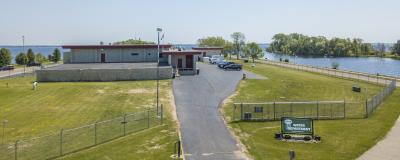Municipal Water Utility
An Overview
A private water company that subsequently operated the system constructed the original "Water Works" at Escanaba in 1887. The system consisted of steam pumps, boilers, infiltration well and 12" intake to Little Bay deNoc. The private franchise renewal in 1906 was contingent upon the construction of a Water Filtration Plant to address water quality problems. A six million-gallon per day treatment plant was completed in 1908 and the City purchased the entire system in 1918. A 1938 engineering report on the treatment plant cited exposed reinforcing steel, poor aggregate and reduced capacity to recommend that a new plant be built. Five deep wells were drilled in 1940 to avoid construction of the recommended plant but limited capacity and poor ground water quality required continuing use of the deteriorated lake treatment plant. The City of Escanaba built the existing treatment plant on Sand Point in 1952. The plant received upgrades over the years to bring the capacity to eight million gallons per day and to keep pace with modern technology.
Today Escanaba Municipal Water Utility serves 5000 customer connections in Escanaba, 180 Wells Township customer connections and provides fire protection within the service area maintaining 700 fire hydrants and supplying direct connections for standby fire sprinkler systems.
Water is obtained from Little Bay deNoc as the raw water source for the treatment plant. Total system capacity is 8,000,000 gallons per day. Current maximum summer demand is 4,000,000 gallons per day with a daily average of 2,500,000 gallons. The treatment plant has the capacity to store a total of 1,000,000 gallons in an underground tank. Two 500,000 gallon elevated storage tanks are strategically located on the distribution system to bring total storage capacity to 2,000,000 gallons. Water is distributed to customers in the service area through 80 miles of cast iron water mains located primarily in street right of ways.
Escanaba Municipal Water Department employs 10 individuals and spends $1,000,000 annually to operate the Utility. Three operators, certified at the highest level by State of Michigan, operate the treatment plant 365 days per year on two operation shifts. One Operator/Mechanic maintains the treatment plant and equipment. A supervisor and three person construction crew of Michigan certified operators builds and maintains the distribution system, customer connections and fire hydrants in the water distribution system. One customer service employee maintains water meters, provides customer service and operates a comprehensive cross connection control program to protect water quality in the distribution system. The Water Department Superintendent manages the utility.
Source Water
Escanaba Municipal Water Utility obtains all of the 2,500,000 gallons per day needed by our customers from an intake located in Little Bay deNoc. Water quality in Little Bay deNoc is affected by winds, water levels and exotic species such as Zebra Mussels causing turbidity, color, tastes, odors and other variables that the treatment plant and staff must address to produce a drinking water of consistent quality.
Treatment Plant
The water treatment plant is located in Ludington Park on Sand Point at One Water Plant Road. The plant is a complete treatment facility incorporating taste and odor control, disinfection, sedimentation, corrosion control, fluoridation and filtration.
Taste and odor are treated for in the intake utilizing from one 1 to 5 pounds of powdered activated charcoal in every million pounds of water. The activated charcoal adsorbs many tastes and odors and all are subsequently removed later in the treatment process.
The disinfection process inactivates viruses, bacteria and other organisms using chlorine which is added to the water in two locations insuring a high level of efficiency in this very critical part of the treatment process. Drinking water leaving the plant must have a chlorine level of 1 pound in every million pounds of water to provide residual disinfection capability until water reaches the customer. The presence of a small chlorine taste confirms that your drinking water quality has not deteriorated.
The sedimentation process is aided by the application of alum (aluminum sulfate) to the raw lake water this material when added to water containing normal debris such a mud, particles and color causes these materials to clump and settle to the bottom of sedimentation tanks where it is removed. The clear water at the very top of these units is skimmed off leaving the alum and debris behind.
The waters of Little Bay deNoc are slightly corrosive to metals and must be treated to reduce that corrosiveness. Soda ash (sodium carbonate) is added to the settled water at a rate of about 30 pounds in every one million pounds of water to increase the pH and control corrosion. The less corrosive water minimizes the chance of dissolving metals such as lead and copper into the drinking water from plumbing fixtures in the home.
The settled water is also treated with 1 pound of fluoride in every one million pounds of water. Fluoridated water is very effective in reducing tooth decay.
Filtration through sand filters is the final treatment process prior to distributing drinking water to customers. Properly operated rapid sand filtration will remove most particles and inactivated organisms from the water supply and is a most important final step in the treatment process.
Distribution System
Water is distributed to customers via approximately 80 miles of water mains ranging in size from 16" in diameter down to 4" located primarily in street right of ways. This pipe is made of cast iron and ductile iron, is lined on the interior with portland cement and on the outside with bituminous coating. There are approximately 5000 customer connections ranging in size from ½" to 10" in diameter serving individual buildings. The system is controlled by approximately 2000 underground main line valves and fire protection is provided by over 700 fire hydrants.

